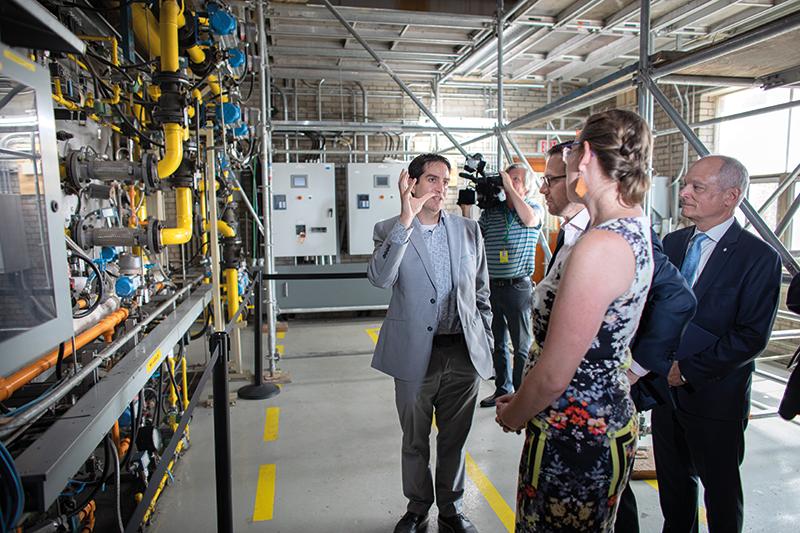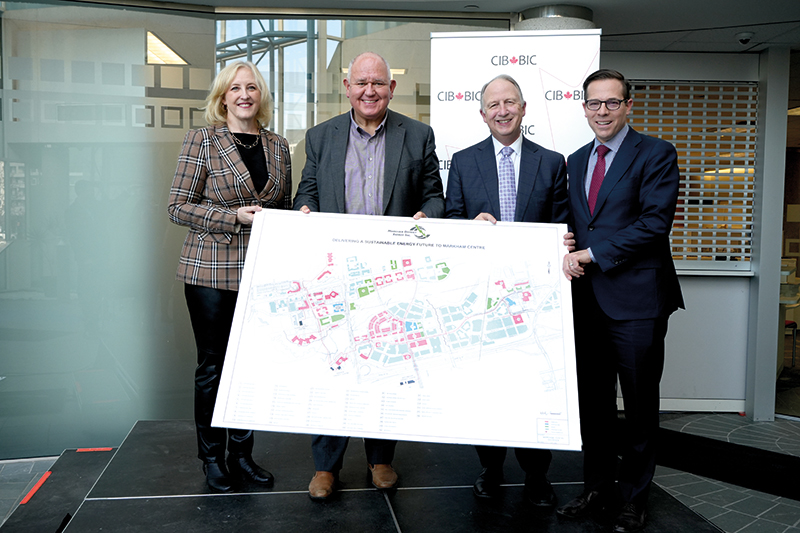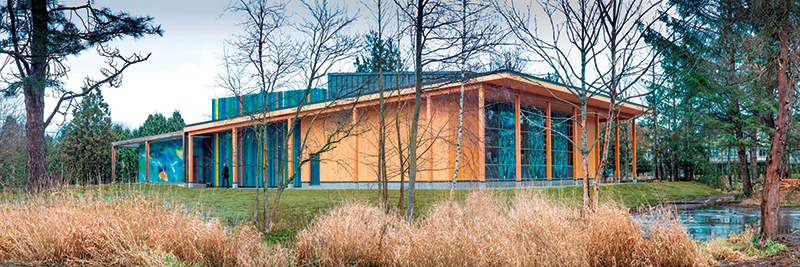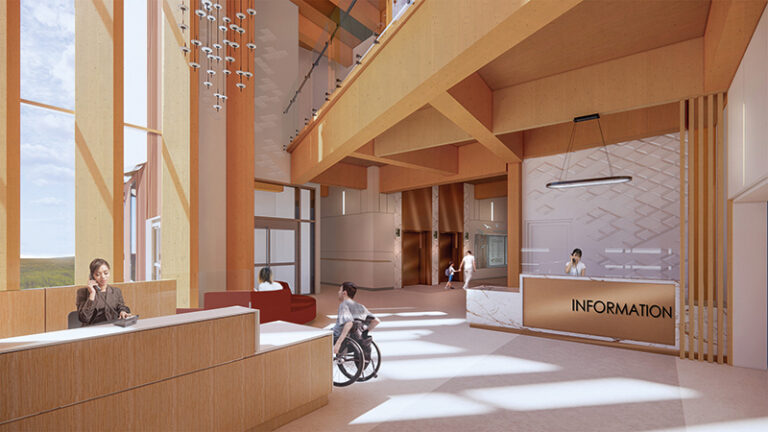By Glenn Miller
Making tangible progress on climate goals in a country as spread out and geographically diverse as Canada was always going to be a challenge. More than four years after Justin Trudeau’s 2019 election pledge to achieve net-zero emissions by 2050, the government is counting on its 2030 Emissions Reduction Plan—a roadmap to guide dramatic reductions in key sectors including energy producers, traditional industry, transportation, and the buildings sector—to complement the Canadian Net-Zero Emissions Accountability Act released in early 2022.
Many, including the media are quick to remind the government that its track record in meeting climate goals has previously been less-than-stellar. But recent reports from the buildings sector, which according to the Canada Green Building Council, accounts for about 30 per cent of all emissions (this includes energy to power buildings as well as energy used to create construction materials and the construction process itself), are cause for optimism.
MUSH sector leading the way
A key factor distinguishing the buildings sector is that the driving force behind emissions reductions is local. Canada’s MUSH sector—municipalities (and Indigenous communities), universities, schools and hospitals—is forging ahead aggressively. Working collaboratively with blue chip pension funds and a growing number of private sector energy companies, MUSH organizations are tapping government funding to establish a new crop of innovative district energy (DE) projects that reduce emissions by relying on low and non-carbon energy. The prevailing attitude seems to be “Just do it—the time for negative talk is over,” says one observer.
Municipalities are setting the stage for emissions reductions in a variety of ways. More than 600 municipalities and First Nations communities having declared climate emergencies. About two thirds have either adopted or are in the process of creating Community Energy and Emissions Plans (CEEPs). A smaller number have taken the additional step of incorporating specific policies in their official community plans that commit the municipality to pressing ahead with district energy projects. When fledgling DE networks lack critical mass as they seek to expand, developers are often required to ensure buildings are at least DE-ready.
Richmond, B.C. is a good example of using municipal policy—inspired, some say, by decisions made more than a decade ago in Vancouver’s Southeast False Creek neighbourhood to take a chance on alternative sources of feedstock to power its DE system—to set the agenda for emissions reductions. Richmond is working in concert with the Canadian Infrastructure Bank (CIB) to make investments that will allow the city and its utilities to “accommodate long-term capital drawdown.” The CIB anticipates as much as 50 million square feet of development in the region could eventually rely on zero carbon energy using a combination of geo-exchange and sewer heat capture. This long-term vision builds on Richmond’s original commitment to district energy made in 2013 when it incorporated the Lulu Island Energy Company (LIEC).
The first of three zones under the direction of LIEC—the Alexandra District Energy Utility (ADEU)—currently services more than 2,200 residential units and a significant amount of commercial space, including the first Walmart ever to be connected to DE. The system relies on a combination of ground-source heat pumps and geo-exchange technology. Natural gas is only used on the coldest days of the year.
The second zone is Richmond City Centre. Its award-winning plan “ensures new developments…are built with an on-site low-carbon energy … compatible with the future City Centre District Energy Utility (CCDEU) …which will primarily use sewer heat reclamation as a zero-carbon source of energy.” The practical result is that the mechanical systems of new developments not yet serviced by the district energy utility have been designed to be “DE ready,” and will be connected in due course.
A key factor affecting municipal strategies is the regulatory environment and the “culture of decision-making.” In B.C., for example, where energy is regulated under the Utilities Commission Act, the norm is for municipalities to make climate-friendly initiatives like district energy a requirement in their plans. Yet in Ontario, where energy prices are also regulated (by the Ontario Energy Board), the culture is very different.
According to Bruce Ander, president and CEO of Markham District Energy (MDE), arguably the most successful municipally owned energy utility in the country, creating a thermal grid—networks of underground piping that distribute hot water (for heating) and chilled water (for cooling) from a central plant, via a closed-loop to surrounding buildings—is an essential condition for meeting net-zero targets. “But implementing DE projects isn’t for the faint of heart,” Ander cautions. “There are so many factors involved, including a need to base investment decisions on a sound business case and an ability to work constructively with partners to raise capital.”
Ander observes that Ontario municipalities typically stop short of requiring DE in their official plans, preferring to avoid forcing developers to make risk-laden decisions while redevelopment plans are still fluid. The example of Lakeview Village in Mississauga is a case in point. Having to commit to DE early on, while still working through cost challenges involved with remediating the 177-acre former power plant, could have scuttled the project, Ander suggests.
By the time Enwave agreed in June 2022 to partner with the Region of Peel to manage the project’s DE system, the development partners had successfully negotiated most of the required planning approvals that will see construction of up to 8,000 residential units as well as significant commercial, recreational and institutional space. The challenge of achieving a sufficient energy baseload to justify proceeding with DE is met by a scheme that will capture waste heat from treated effluent from an adjacent sewage treatment plant.
Through Enwave, the CIB is investing significant dollars in the Mississauga project. According to Peel’s general manager of water and wastewater, Anthony Parente, Lakeview Village could be the catalyst to help Mississauga reduce GHG emissions by 80 per cent by 2050. CIB and Enwave are also working to increase the impact of downtown Toronto’s deep lake water cooling district energy network, reflecting a $600 million commitment from CIB.

Universities using DE
A decades-old decision to rethink how to best benefit from a massive land grant proved to be a turning point for Simon Fraser University on its journey towards net-zero. This led to the formation of SFU Community Trust in the 1990s to develop University City—a pedestrian-friendly community adjacent to the main campus at the top of Burnaby Mountain. Destined to house up to 10,000 residents at final build out, more than half of the community now gets heating and hot water from a DE system relying on a biomass plant using diverted wood waste. The plant also serves most of the campus, making SFU one of the greenest universities in B.C., if not Canada.
The DE system was developed in partnership with Corix Utilities and benefited from a grant provided by B.C.’s Public Sector Energy Conservation Agreement. “Connecting to the Corix energy plant will ensure homes have high-quality energy for space heating and hot water while significantly reducing their carbon footprint,” notes Dale Mikkelsen, CEO of the Trust. “Biomass combustion recycles the carbon already in the natural carbon cycle with no additional CO2 added to the atmosphere.”
In Ontario, the CIB is also partnering with the University of Toronto, which has embarked on a massive long-term modernization process of its ancient (by DE standards) district heating system as part of its Low Carbon Action Plan. CIB hopes to leverage U of T’s high-profile to encourage other universities and colleges to follow U of T’s lead. Elsewhere in Toronto, York University already operates a co-generation district energy facility and its first foray into York Region, a new campus to be connected to DE in Markham Centre is currently under construction.
Fostering continuous innovation
Whether it is capturing energy from wave action on the west coast to power DE communities or turning to energy from waste to supply a DE project in Newfoundland, the emergence of a new crop of innovative energy companies is helping renew interest in district energy across the country. The common denominator is a commitment to net-zero that is both policy-led and pecuniary self-interest. In Toronto, building on a brave decision made by OMERS more than 20 years ago to turn a radical idea—deep lake water cooling—into a platform that has since proved its worth to blue chip investors, the blurring of lines of responsibility between city builders and energy companies can only have positive impacts for Canadian communities in search of net-zero emissions.
[This article originally appeared in the March/April 2023 edition of ReNew Canada.]
Glenn Miller, FCIP is a senior associate with the Canadian Urban Institute.
Featured image: In Vancouver’s False Creek neighbourhood, the Alexandra District Energy Utility services more than 2,200 residential units and a significant amount of commercial space, including the first Walmart ever to be connected to DE. (Lulu Island Energy Company)
Markham District Energy a model of collaboration

With more than 200 buildings under its control, accounting for some 13 million square feet of development, Markham District Energy (MDE) was the first system in North America to introduce combined heat and power (CHP)—a highly efficient approach that concurrently produces electricity and thermal energy from a single energy source. At present, MDE relies on natural gas as its primary fuel for heating but plans to transition to non-carbon energy sources when conditions are right. To that end, the CIB and CIBC recently committed a total of $270 million to be invested over the next 10 years to fund both expansion and the application of fuel-switching technology such as capturing waste heat from York Region’s trunk sanitary sewer. Another low-carbon approach currently being tested thanks to a $10-million injection of capital from the Federation of Canadian Municipalities is a biomass plant, which is fed by wood pellets.
According to Bruce Ander, MDE’s president and CEO, these moves are part of MDE’s plan to continue serving development that is net-zero ready, capable of reducing emissions by more than 30,000 tonnes of greenhouse gas emissions annually.
As a utility owned by the municipality, MDE is already a poster child for MUSH sector collaboration, providing thermal energy to two high schools, municipal buildings, recreational facilities, Markham Stouffville Hospital (the anchor of MDE’s second network) as well as many commercial, residential, and institutional customers. In 2023, MDE will connect a new York University campus to its system that is currently under construction in Markham’s downtown core. – Glenn Miller











